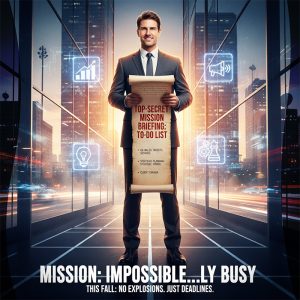
December Business Playbook: Retain Clients & Boost Revenue
Prepare Your Business for Q1 2026 December is not just
By Jean-Charles Spanelis- August 3, 2025

In today’s increasingly volatile and complex world, leaders face a constant stream of challenges: economic fluctuations, geopolitical instability, rapid technological shifts, and evolving employee expectations. Traditional management models based on fixed plans and long-term forecasts are showing their limits. To stay competitive and resilient, organizations must learn to lead through uncertainty. This is where agile leadership comes into play — not just as a set of tools, but as a mindset and a strategic advantage.
Agile leadership is inspired by methodologies like Lean, Design Thinking, and Agile software development. It’s about accepting that not everything can be predicted, but much can be learned and adapted in real time. It means organizing not to control uncertainty, but to work with it — creatively and effectively.
Managing uncertainty begins by recognizing that change is no longer an exception — it is the rule. Agility means accepting that some decisions will need to be revised, that plans are made to evolve, and that flexibility and collaboration are more powerful than rigid structures.
Agile leaders act more like facilitators than commanders. They actively listen, observe emerging patterns, and help their teams stay focused and united, even when the context is ambiguous. Their role is to create clarity without oversimplifying complexity, and to support forward movement even when the destination isn’t perfectly clear.
While agile methodologies are often associated with tools and frameworks, real agility starts with a leadership mindset. It’s the willingness to be open, to test and learn, and to co-create solutions with the team.
Agile leaders don’t pretend to have all the answers. They build psychological safety, where team members are encouraged to speak up, take initiatives, and learn from mistakes. They encourage collective intelligence rather than relying solely on hierarchy or past expertise.
This mindset requires letting go of control in favor of trust — trust in the team, trust in the process, and trust in the capacity to adapt. It also requires new ways of working: short feedback loops, iterative planning, and a strong focus on outcomes rather than procedures.
To embed agility in daily operations, structured rituals play a critical role. These are not just meetings, but purposeful moments that help teams navigate complexity together:
Such rituals reinforce visibility, transparency, and shared responsibility. They also foster a rhythm that reduces uncertainty by creating regular touchpoints.
👉 See also: Structuring a Commercial Organization in Times of Complexity
At the core of agile leadership lies a human-centric approach. Agile leaders don’t just manage tasks — they empower people. They listen deeply, recognize contributions, and support growth. They know that team performance depends on engagement, trust, and the freedom to experiment.
Agile leaders create the conditions for individuals to take ownership, even in uncertain times. They promote autonomy while remaining available for support and guidance. In doing so, they help teams move from reactive to proactive modes of working.
Importantly, agility also requires collective trust — not only in individuals, but in the system itself. Organizations must trust their teams to navigate ambiguity and must build cultures that support iterative learning rather than punishing imperfection.
👉 Also read: Boost Your SME’s Commercial Efficiency Through Outsourcing
Companies that embrace agile leadership at all levels — from C-suite to project teams — are proving to be more resilient, more innovative, and better equipped to handle complexity. Agility doesn’t mean abandoning structure; it means choosing adaptive structures that evolve in response to new realities.
Agile practices can be applied both strategically and operationally. Executive teams can adopt short decision-making cycles. Project teams can use feedback loops and daily standups. Individual leaders can shift from trying to control everything to enabling shared problem-solving.
And while agility may start with individuals, it thrives in cultures that support learning, experimentation, and emotional safety. Coaching is often a powerful enabler in this transition, helping managers adopt new mindsets and build lasting habits of adaptability.

Prepare Your Business for Q1 2026 December is not just

Between strategy, leadership, and delegation, learn how CEOs can transform their overwhelming to-do lists into powerful instruments of business clarity.

Understanding your website visitors means unlocking insights to sharpen your sales strategy, personalize outreach, and drive measurable results.

Lead generation is no longer about quantity but quality. In 2025, success comes from targeting the right prospects and guiding them with trust and care.

There is no absolute winner in the CRM battle. The right CRM is the one that matches your goals, teams and sales maturity.

Leadership can be isolating. Executive coaching provides support, perspective, and tools to help leaders make confident and effective decisions.